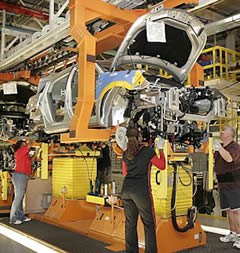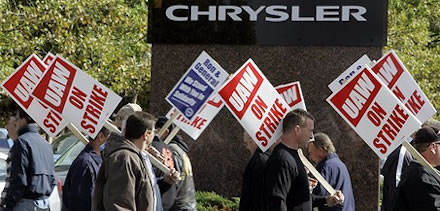Posted December 6, 2007
Earlier this month, we featured coverage of events in Pakistan after President Musharaff declared martial law. As events have heated up again following the assassination of Pakistan People’s Party leader Benazir Bhutto, be sure to look at our International Spotlight on Pakistan page. We also have a section on the Venezuelan referendum.
The United Auto Workers (UAW) four-year contracts with General Motors, Chrysler and Ford contain cuts that mark the end of high-paying jobs in the U.S. auto industry. Even with the constraints under which the union went into negotiations that was not inevitable.
The 2007 contracts cut wages and benefits for all future workers, divided the workforce into “core” and “non-core” jobs, substituted bonuses for a wage increase and allowed the corporations to pay at most seventy cents on the dollar to escape from their commitment to retiree health care. With local contracts to follow, the system is set up like musical chairs, designed so that each UAW local will be compelled to offer additional concessions and thus underbid other locals for jobs.
Often portrayed in the media as selfish, auto workers felt the introduction of two-tier wages shafted the next generation and the change in retiree health care endangered the generation that had built a powerful union. An opposition to the concessions emerged, but it proved unable to stop the official UAW steamroller.
Opposition at Chrysler was the strongest. When the negotiating team there rejected the terms the UAW International had bargained, they were pressured into re-voting the same package until they broke—but the vote was not unanimous. The team’s chair, Bill Parker, President of UAW Local 1700, distributed a leaflet outlining the unacceptable level of concessions (link to .pdf). That leaflet was the manifesto that nearly defeated the proposed contract.
The UAW International dispatched its propagandists to plant-by-plant informational meetings, promising, cajoling and pressuring. The union’s Chrysler Department sent out a letter directing all appointed representatives to demonstrate their “solidarity” with the proposed agreement by signing on the dotted line.
Although voted down by most assembly plants, the Chrysler contract passed by 54%.
Analysts predict that by the end of the contract between 33 and 40% of all jobs will be in the newly created second tier. Starting wage is pegged at $14 an hour (this represents 90% of today’s average manufacturing wage, for union and non-union workers alike). That’s about half the wage current workers make, and the new benefit package is below par. Judging by what transpired at Delphi, the huge auto parts maker that extracted concessions through bankruptcy, we predict that within one or two contracts the higher tier and the defined-benefits package will disappear. The second tier will become the standard.

Of course Ford, Chrysler and General Motors claim they must cut labor costs in order to rebuild their market share, and clearly UAW officials believe the union must embrace “jointness” to “save jobs.” But the figures don’t back them up. Back in 1979, when the UAW first granted concessions, 450,000 UAW workers were employed by GM alone. Today there are 73,000 — and GM is planning on further “buyouts.”
Following negotiations, General Motors proudly announced that the new contract meant the wage difference between the corporation and Toyota had been reduced by two thirds. Of course Toyota has now announced it will reduce its labor package, so the spiral continues downward. The fundamental problem in the auto industry, however, is not labor cost — especially given the rise of labor productivity — but rather management’s failure to develop fuel-efficient products that people want to buy.
Management’s skimping on research and development, its decision to produce only the most profitable gas-guzzling vehicles and its increasingly lavish bonuses and stock options has left the industry with an urgent need to restructure. So why does the UAW insist that its members need to sacrifice in order to make the U.S.-based auto companies stronger?
The reality is that the 2007 contracts strengthen the UAW’s partnership with the corporations — but notice that the relationship is not reciprocal. Just a few days after the contracts were signed both GM and Chrysler announced another round of layoffs, embarrassing the UAW but pleasing Wall Street.
The contracts makes it almost impossible for the UAW to organize the growing number of autoworkers who are not in a union. As GM, Ford and Chrysler shrink the Japanese, Korean and German transplants are opening new facilities. Why join a union that just signed a 50% pay cut?

UAW Picket in front of Chrysler headquarters.
During the 2007 negotiations a plainspoken opposition confronted the corporation’s drive to reverse the working conditions, benefits and wages won over the past fifty years. They did not buckle under the weight of lies and pressure but insisted on solidarity as a core union principle. As one Detroit Free Press reporter quoted a skilled trades committeeperson: “Two-tier wages have no place in this union… if you vote for this agreement, you might as well get a gun and shoot yourself in the head.”
The 2007 UAW contracts are a giant backward step. They undermined the basis of unionism itself: to take labor out of competition. They encouraged passivity among the ranks when boldness, creativity and above all, solidarity, were required. Given the health care crisis, the UAW could have demanded that the corporations go to the federal government and demand single-payer health care for all.
The leadership of the union, however, was incapable of turning the auto industry’s “crisis” into an opportunity to build a grand coalition to force passage of a national health care bill. If they had taken that road they would have won respect for championing the needs of all working people and opened the door to new organizing possibilities.
To read the writings of autoworkers and their allies, check out the following websites:
- Soldiers of Solidarity (SOS), a grouping of rank and file UAW members
- SOS and the negotiation & ratification of the 2007 UAW Auto Industry Contracts
- http://factoryrat.com
- http://futureoftheunion.com
- Labor Notes, a labor news monthly published since 1979
- The Center for Labor Renewal
You will also find many articles in Against the Current about the auto industry. These can be found on the website or in back issues. Most recent articles include:
“When the UAW Was Young,” an interview with Erwin and Estar Baur, ATC 131 (Also, read the introduction to the article)
“Auto Armageddon?” by Dianne Feeley, ATC 130

